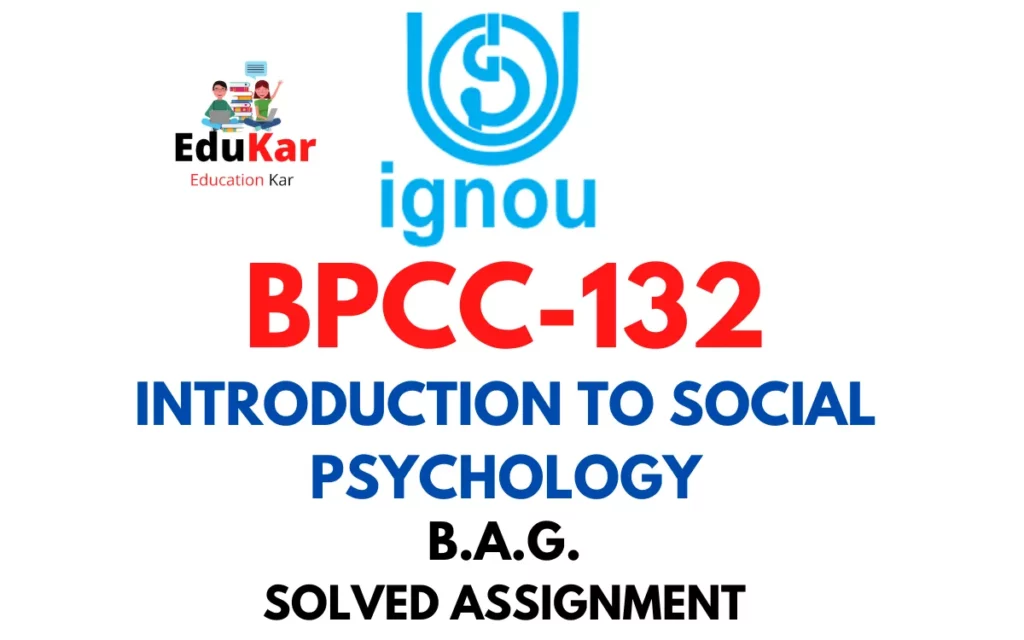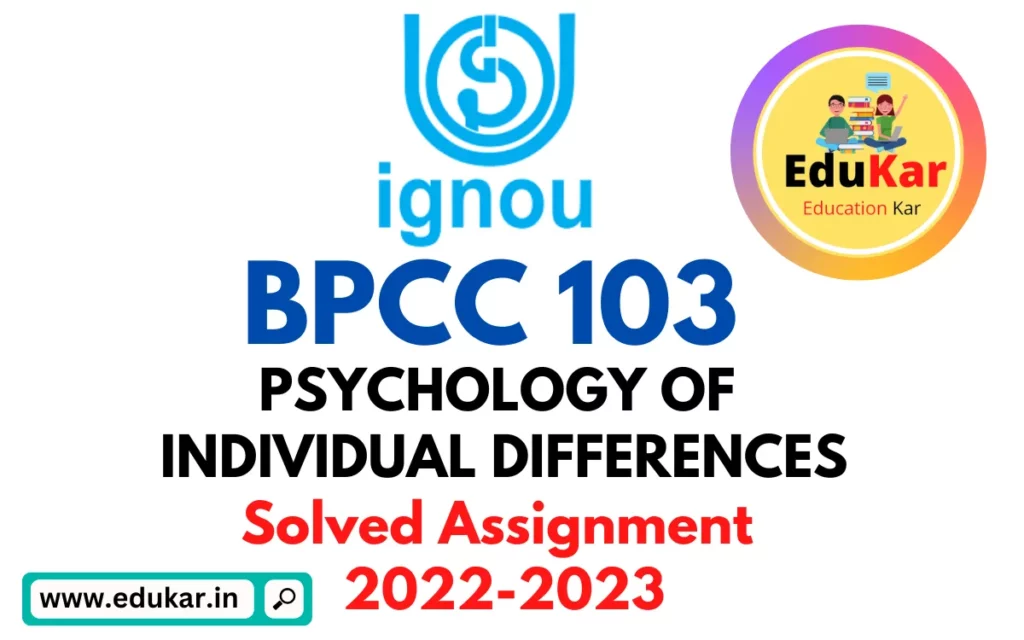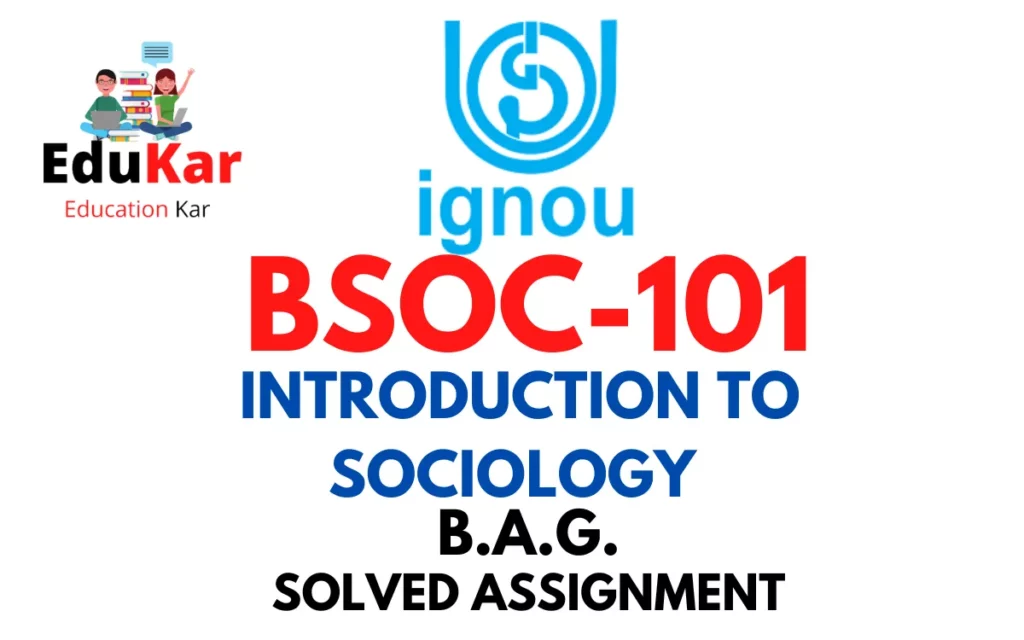Contents
- 1 Assignment One
- 2 Answer the following descriptive category questions in about 500 words each. Eachquestion carries 20 marks.
- 3 1. Define character strengths. Describe the VIA classification of strengths and virtues.
- 4 2. Explain mindfulness. Describe the benefits of mindfulness.
- 5 Assignment Two
- 6 Answer the following middle category questions in about 250 words each. Each question carries 10 marks.
- 7 3. Give a historical perspective on positive psychology.
- 8 4. Explain self-efficacy. Describe strategies for enhancing self-efficacy.
- 9 5. Explain multicultural mindset.
- 10 Assignment Three
- 11 Answer the following short category questions in about 100 words each. Each question carries 6 marks.
- 12 6. Social psychology and positive psychology
- 13 7. Pancha kosha model
- 14 8. Broaden-and-Build theory of positive emotions
- 15 9. Hedonic and Eudaimonic perspective
- 16 10. Resilience as ordinary magic
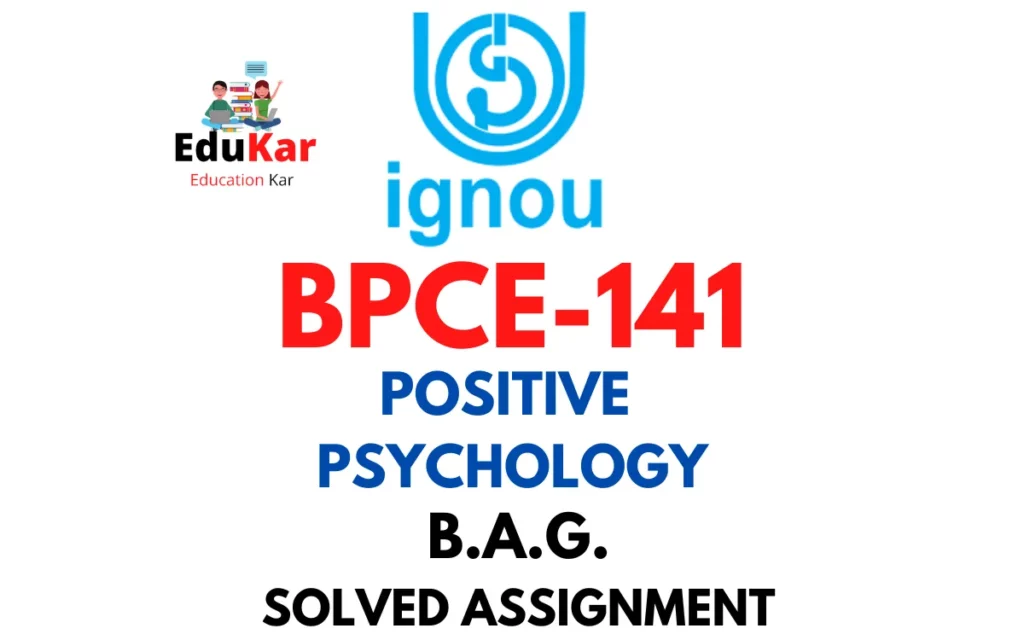
| Title | BPCE-141: IGNOU BAG Solved Assignment 2022-2023 |
| University | IGNOU |
| Degree | Bachelor Degree Programme |
| Course Code | BPCE-141 |
| Course Name | POSITIVE PSYCHOLOGY |
| Programme Name | Bachelor of Arts (General) |
| Programme Code | BAG |
| Total Marks | 100 |
| Year | 2022-2023 |
| Language | English |
| Assignment Code | Asst /TMA /2022-23 |
| Last Date for Submission of Assignment: | For June Examination: 31st April For December Examination: 30th September |
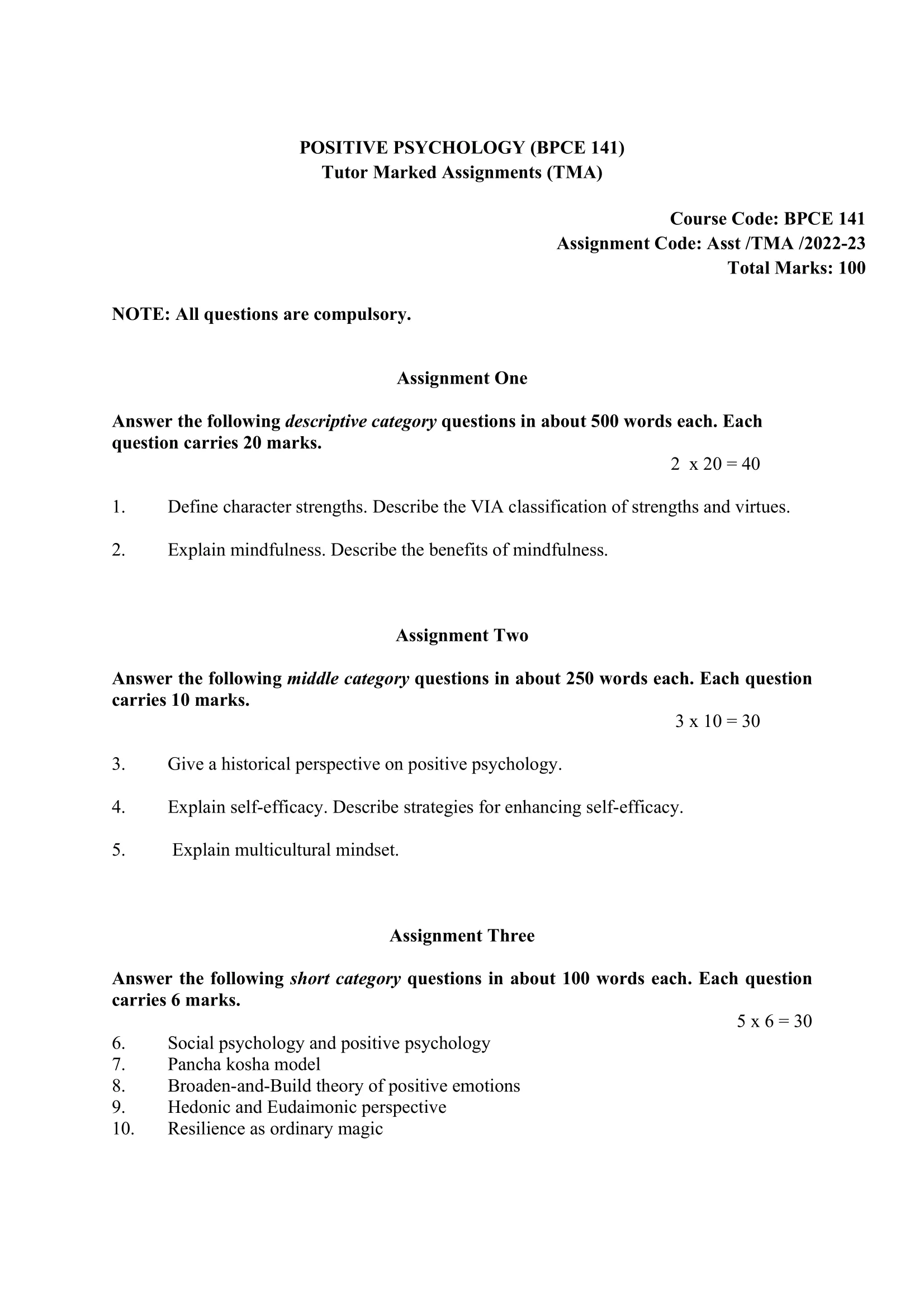
Assignment One
Answer the following descriptive category questions in about 500 words each. Each
question carries 20 marks.
1. Define character strengths. Describe the VIA classification of strengths and virtues.
Ans: Character strengths refer to positive traits and qualities that individuals possess and use to approach and deal with various situations in life. These strengths are part of an individual’s character and are believed to be innate and can be developed and cultivated through practice and use. Some examples of character strengths include creativity, honesty, kindness, courage, and perseverance, among others.
The VIA (Values in Action) classification of strengths and virtues is a framework developed by psychologists Christopher Peterson and Martin Seligman to identify and classify character strengths into six broad categories. These categories include:
- Wisdom and Knowledge: This category includes strengths such as creativity, curiosity, judgment, love of learning, and perspective, among others.
- Courage: This category includes strengths such as bravery, perseverance, honesty, and zest, among others.
- Humanity: This category includes strengths such as kindness, love, and social intelligence, among others.
- Justice: This category includes strengths such as fairness, leadership, and teamwork, among others.
- Temperance: This category includes strengths such as forgiveness, humility, prudence, and self-regulation, among others.
- Transcendence: This category includes strengths such as appreciation of beauty and excellence, gratitude, hope, and spirituality, among others.
Each of these categories has specific strengths that are associated with them, and these strengths can be used to promote personal growth and well-being, as well as to help individuals connect with and contribute to their communities and society as a whole. The VIA classification of strengths and virtues has been widely used in research, education, and clinical practice to help individuals identify and leverage their strengths to achieve their goals and improve their lives.
2. Explain mindfulness. Describe the benefits of mindfulness.
Ans: Mindfulness refers to the practice of being fully present and aware of one’s thoughts, feelings, bodily sensations, and surrounding environment, without judgment or distraction. It involves paying attention to the present moment and accepting it as it is, rather than focusing on the past or worrying about the future.
The benefits of mindfulness are numerous, and they can impact various aspects of an individual’s life, including physical, mental, and emotional well-being. Some of the benefits of mindfulness include:
- Reducing stress and anxiety: Mindfulness can help individuals manage stress and anxiety by teaching them to be present and accepting of their thoughts and emotions, rather than avoiding or suppressing them.
- Improving emotional regulation: Mindfulness can help individuals regulate their emotions and respond to challenging situations with greater clarity and composure.
- Enhancing cognitive function: Mindfulness can improve attention, memory, and decision-making skills, as well as promote creativity and problem-solving abilities.
- Boosting immune function: Mindfulness has been found to improve immune function and reduce inflammation in the body.
- Improving relationships: Mindfulness can help individuals communicate more effectively, develop greater empathy and compassion, and strengthen their relationships with others.
- Enhancing overall well-being: Mindfulness can improve an individual’s overall sense of well-being and satisfaction with life, as well as promote a more positive outlook on life.
There are various ways to practice mindfulness, including meditation, yoga, mindful breathing, and mindful eating, among others. Regular practice of mindfulness can lead to these benefits and ultimately help individuals lead a happier, healthier, and more fulfilling life.
Assignment Two
Answer the following middle category questions in about 250 words each. Each question carries 10 marks.
3. Give a historical perspective on positive psychology.
Ans: Positive psychology is a relatively new field of psychology that focuses on studying the positive aspects of human life, such as happiness, well-being, resilience, and flourishing. The roots of positive psychology can be traced back to ancient Greek philosophy, which emphasized the importance of leading a meaningful and virtuous life. However, the modern-day positive psychology movement emerged in the late 20th century as a response to the dominant paradigm of psychology, which focused primarily on diagnosing and treating mental illness.
One of the key figures in the development of positive psychology is Martin Seligman, who is often referred to as the father of positive psychology. Seligman first introduced the concept of positive psychology in a presidential address to the American Psychological Association in 1998. In this address, Seligman called for a shift in psychology’s focus from the study of pathology and negative states to the study of positive states and experiences.
Since then, positive psychology has grown into a multifaceted field of research and practice. Researchers have studied a variety of topics related to positive psychology, including gratitude, mindfulness, forgiveness, positive emotions, and social connections. The field has also produced numerous interventions and techniques designed to enhance well-being, such as positive journaling, mindfulness-based stress reduction, and strengths-based coaching.
Positive psychology has also gained recognition in popular culture, with numerous self-help books, podcasts, and courses promoting its principles. Overall, positive psychology has brought a much-needed balance to the field of psychology, by focusing on the strengths, virtues, and positive experiences that make life worth living.
4. Explain self-efficacy. Describe strategies for enhancing self-efficacy.
Ans: Self-efficacy is a term coined by psychologist Albert Bandura, which refers to an individual’s belief in their ability to perform a specific task or achieve a specific goal. It is a key concept in social cognitive theory, which emphasizes the importance of both cognitive and environmental factors in shaping human behavior. Self-efficacy beliefs influence people’s motivation, effort, persistence, and resilience in the face of challenges.
There are several strategies that individuals can use to enhance their self-efficacy:
- Mastery experiences: One of the most effective ways to enhance self-efficacy is to have success in similar tasks or situations. By experiencing success, individuals gain confidence in their abilities and are more likely to approach similar tasks in the future.
- Vicarious experiences: Observing others successfully perform a task can also enhance self-efficacy. Seeing someone who is similar to oneself achieve success can help individuals believe that they too can succeed.
- Social persuasion: Encouragement and feedback from others can also boost self-efficacy. Positive feedback and support can help individuals feel more capable of performing a task.
- Emotional and physiological states: Self-efficacy can be influenced by emotions and physiological states. Feeling anxious, stressed, or tired can decrease self-efficacy, while feeling calm, energized, and focused can increase self-efficacy.
- Imagery and self-talk: Using positive self-talk and visualizing successful performance can also enhance self-efficacy. By mentally rehearsing success, individuals can build confidence and motivation.
5. Explain multicultural mindset.
Ans: A multicultural mindset refers to a way of thinking and perceiving the world that acknowledges and respects the diversity of different cultures, values, beliefs, and perspectives. It involves a willingness to learn about and appreciate different cultures, as well as an ability to understand and communicate with people from different backgrounds.
A person with a multicultural mindset understands that cultural differences are not weaknesses or obstacles, but rather strengths that can be leveraged for growth and learning. They are curious about other cultures, and seek to understand them on a deeper level. They are open-minded and willing to challenge their own assumptions and biases.
Having a multicultural mindset involves recognizing the historical and systemic factors that have contributed to cultural differences and inequalities, and striving to promote equality and justice for all people, regardless of their background. It also involves actively working to create inclusive environments where everyone feels valued and respected.
Assignment Three
Answer the following short category questions in about 100 words each. Each question carries 6 marks.
6. Social psychology and positive psychology
Ans: Social psychology is the scientific study of how people’s thoughts, feelings, and behaviors are influenced by the presence of others. Social psychologists investigate a range of topics, including social influence, social cognition, attitudes, and group dynamics. They seek to understand how people relate to one another and how social factors impact individual behavior.
Positive psychology, on the other hand, is the study of human flourishing and optimal functioning. It aims to identify the factors that contribute to positive emotions, relationships, and achievements. Positive psychology researchers explore topics such as happiness, resilience, creativity, and character strengths. The goal is to develop interventions and techniques that can help individuals and communities thrive.
While there is some overlap between social psychology and positive psychology, they approach the study of human behavior from different angles. Social psychology tends to focus on how people are affected by their social context, while positive psychology seeks to identify the factors that contribute to well-being and fulfillment. Both fields are important for understanding human behavior and promoting individual and collective growth.
7. Pancha kosha model
Ans: The Pancha Kosha model is a concept from the ancient Indian system of philosophy, known as Vedanta. According to this model, every human being is composed of five layers or sheaths (koshas) that progressively envelop the individual soul (atman).
The first kosha is the Annamaya Kosha, which refers to the physical body and its physiological functions, including the five senses and motor organs. The second kosha is the Pranamaya Kosha, which deals with the vital energy that sustains the body, including breathing and digestion.
The third kosha is the Manomaya Kosha, which represents the mind and its functions, including thinking, feeling, and perceiving. The fourth kosha is the Vijnanamaya Kosha, which pertains to intellect and wisdom, including knowledge and discrimination.
The fifth and final kosha is the Anandamaya Kosha, which is the bliss sheath and is the closest to the soul. This kosha refers to the experience of joy, peace, and unconditional love that comes from a deep connection with the self and the universe.
The Pancha Kosha model is used to explain the interconnectedness of the physical, mental, and spiritual dimensions of human experience. It suggests that each kosha must be nourished and balanced to promote overall health and well-being. The model is still relevant today and is often used in yoga and meditation practices to help individuals connect with their inner selves and cultivate a sense of wholeness.
8. Broaden-and-Build theory of positive emotions
Ans: The Broaden-and-Build theory of positive emotions is a psychological theory that explains how positive emotions can have long-term effects on individuals’ mental health and well-being. The theory was proposed by psychologist Barbara Fredrickson.
According to the theory, positive emotions broaden an individual’s thought-action repertoire and build their personal resources. Positive emotions broaden a person’s scope of attention, cognition, and behavior, allowing them to be more creative, flexible, and resilient in the face of stress and adversity. This broadening effect can lead to new learning and growth opportunities, as well as increased personal resources such as resilience, coping strategies, and social support.
Positive emotions also build personal resources by creating a ripple effect of positive outcomes. Positive emotions lead to positive social interactions, increased physical health, and improved psychological well-being, which in turn generate further positive emotions. This cycle of positivity builds up individuals’ personal resources, which in turn enable them to better cope with negative emotions and stressful situations.
The Broaden-and-Build theory suggests that positive emotions have important implications for mental health, and that cultivating positive emotions can lead to long-term improvements in well-being. It suggests that individuals can develop their personal resources through activities that promote positive emotions, such as practicing gratitude, engaging in acts of kindness, or pursuing hobbies and interests that bring joy and fulfillment.
9. Hedonic and Eudaimonic perspective
Ans: Hedonic and eudaimonic perspectives are two distinct approaches to understanding human well-being and happiness.
The hedonic perspective emphasizes the pursuit of pleasure and the avoidance of pain as key drivers of happiness. According to this perspective, the goal of life is to maximize pleasure and minimize suffering, and happiness is seen as the result of satisfying our desires and needs. Hedonic happiness is often associated with temporary experiences of pleasure, such as material possessions, social status, or indulging in pleasurable activities.
In contrast, the eudaimonic perspective emphasizes the pursuit of meaning and purpose as key drivers of well-being. According to this perspective, the goal of life is to realize one’s potential and lead a life that is meaningful and fulfilling. Eudaimonic happiness is often associated with activities that are challenging, require effort and skills, and provide a sense of personal growth and satisfaction.
While both perspectives can contribute to happiness and well-being, the eudaimonic perspective is often viewed as more sustainable and fulfilling over the long term, as it emphasizes activities that promote personal growth, social connection, and a sense of purpose. Research has shown that individuals who prioritize eudaimonic activities, such as volunteering or pursuing meaningful work, report higher levels of life satisfaction and well-being over time.
10. Resilience as ordinary magic
Ans: Resilience can be seen as ordinary magic because it refers to the ability to adapt and cope with difficult or challenging situations, and to recover from setbacks and adversity. It is a human capacity that allows us to bounce back and continue moving forward, even in the face of adversity.
Like magic, resilience can sometimes seem to come from nowhere, as individuals are able to overcome seemingly insurmountable obstacles or hardships. However, resilience is not a mysterious or mystical force – it is a skill that can be developed and strengthened over time through practice and experience.
At its core, resilience involves a set of psychological and emotional resources that individuals draw upon in difficult times, such as optimism, persistence, and a sense of purpose. These resources help people to maintain a positive outlook, stay focused on their goals, and persevere in the face of challenges.
Resilience is not something that only a few exceptional people possess – it is a capacity that can be cultivated and strengthened by anyone. By practicing self-care, seeking support from others, and learning new coping strategies, individuals can build their resilience and develop the ability to overcome even the most difficult challenges.
How to Download BPCE-141 Solved Assignment?
You can download it from the www.edukar.in, they have a big database for all the IGNOU solved assignments.
Is the BPCE-141 Solved Assignment Free?
Yes this is absolutely free to download the solved assignment from www.edukar.in
What is the last submission date for BPCE-141 Solved Assignment?
For June Examination: 31st April, For December Examination: 30th October



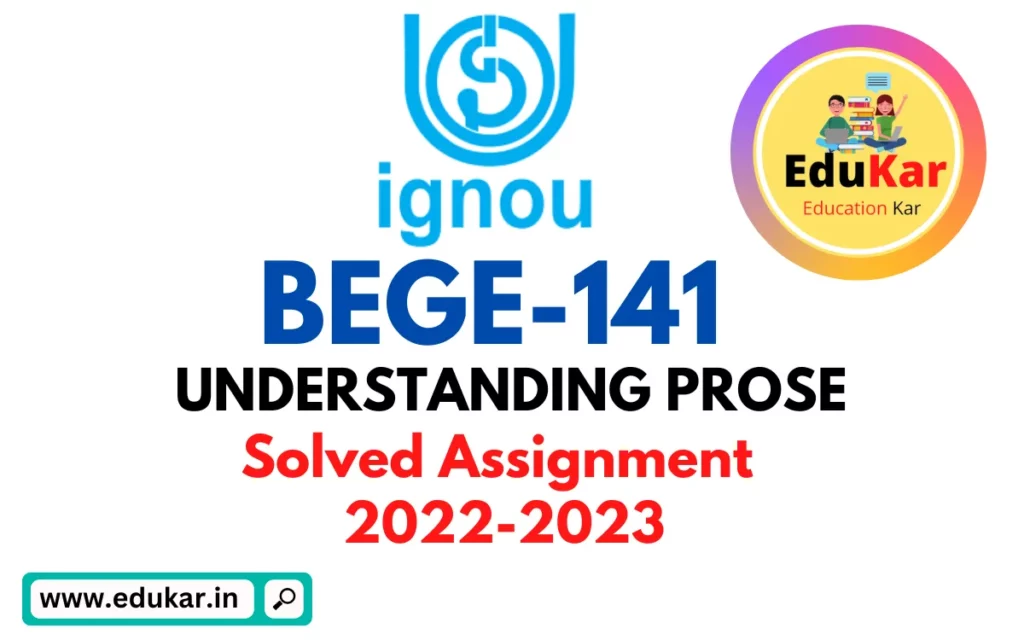
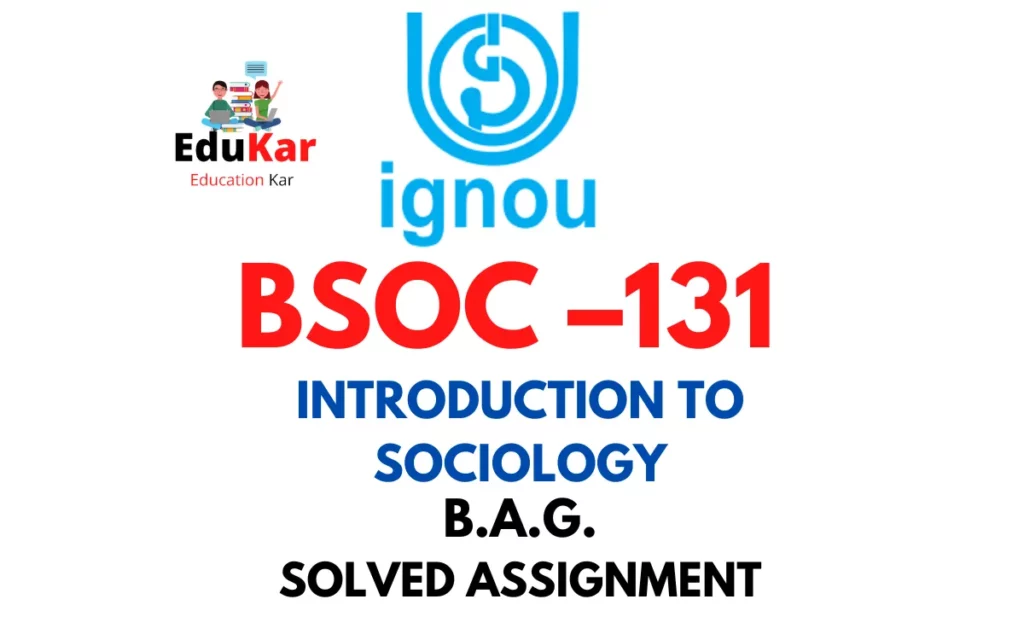
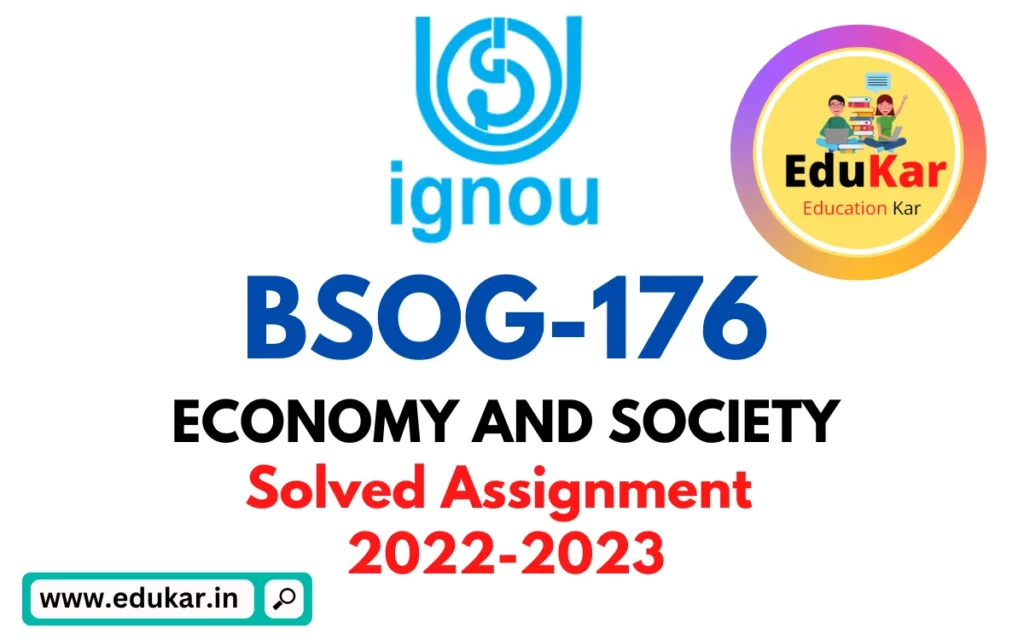
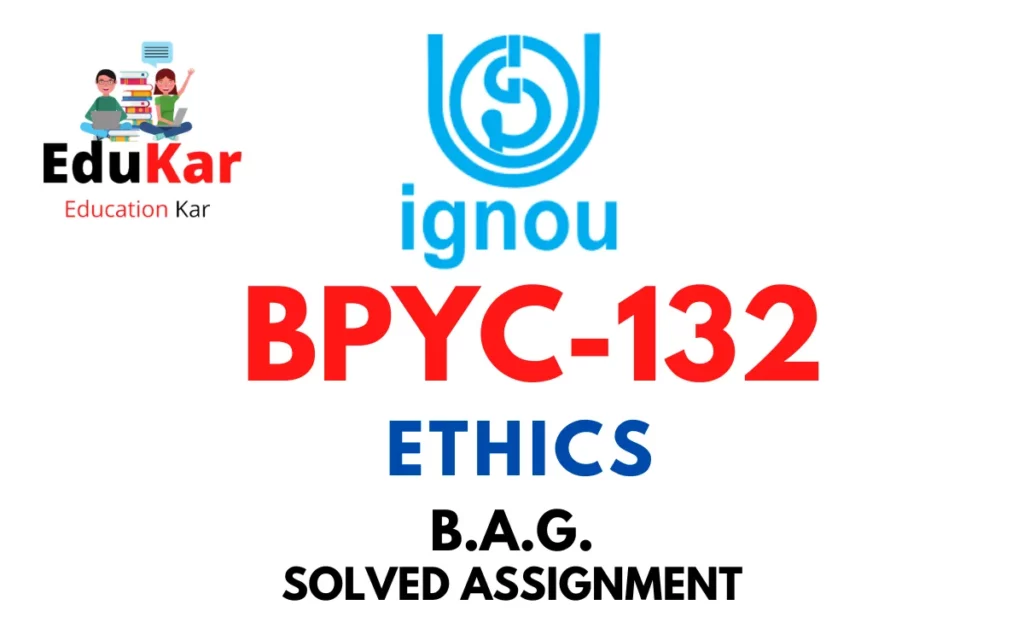
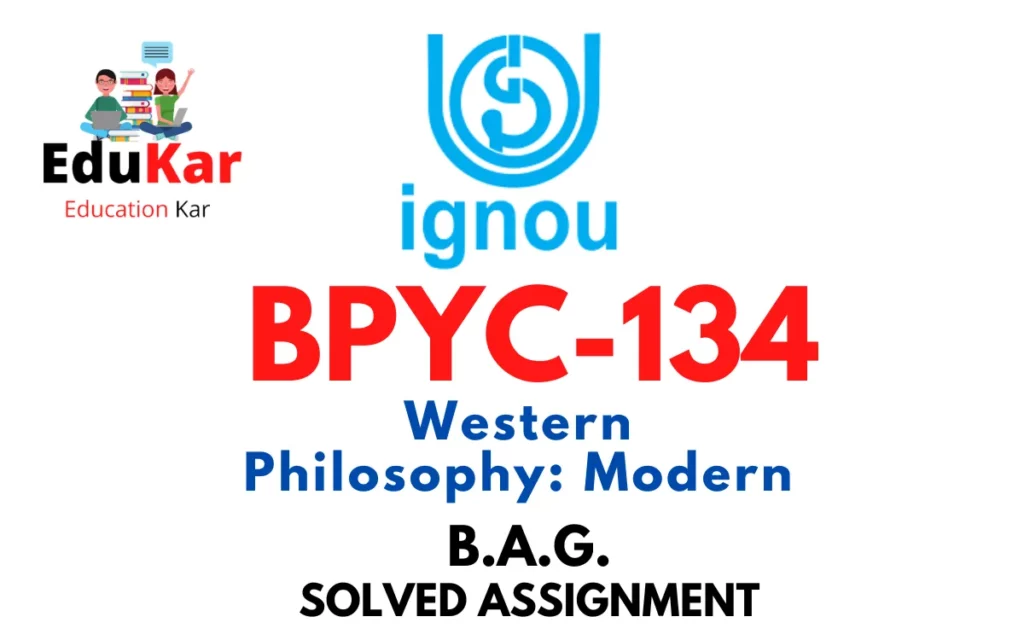
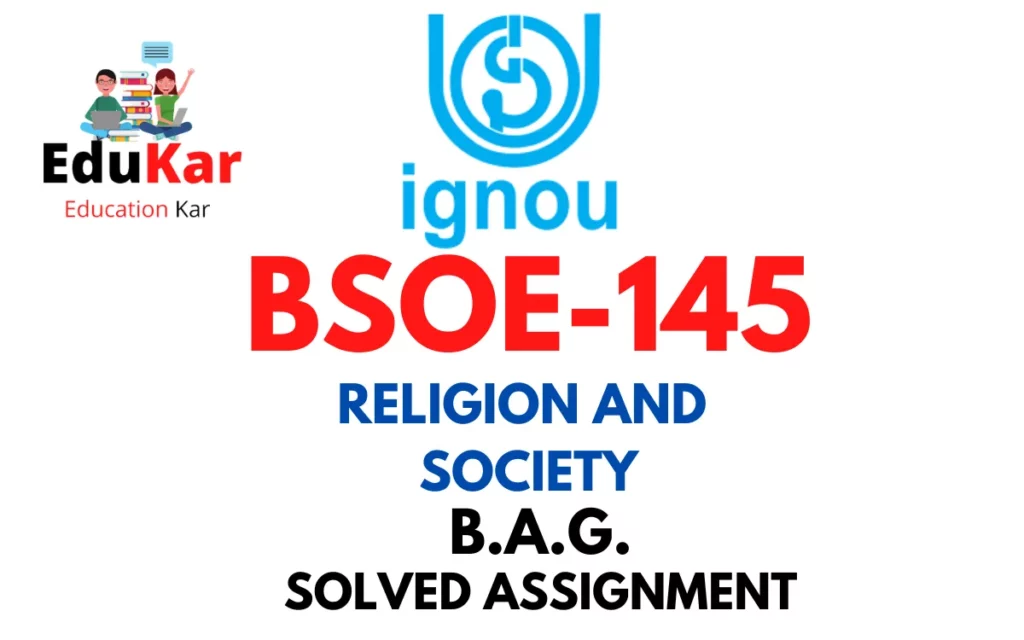
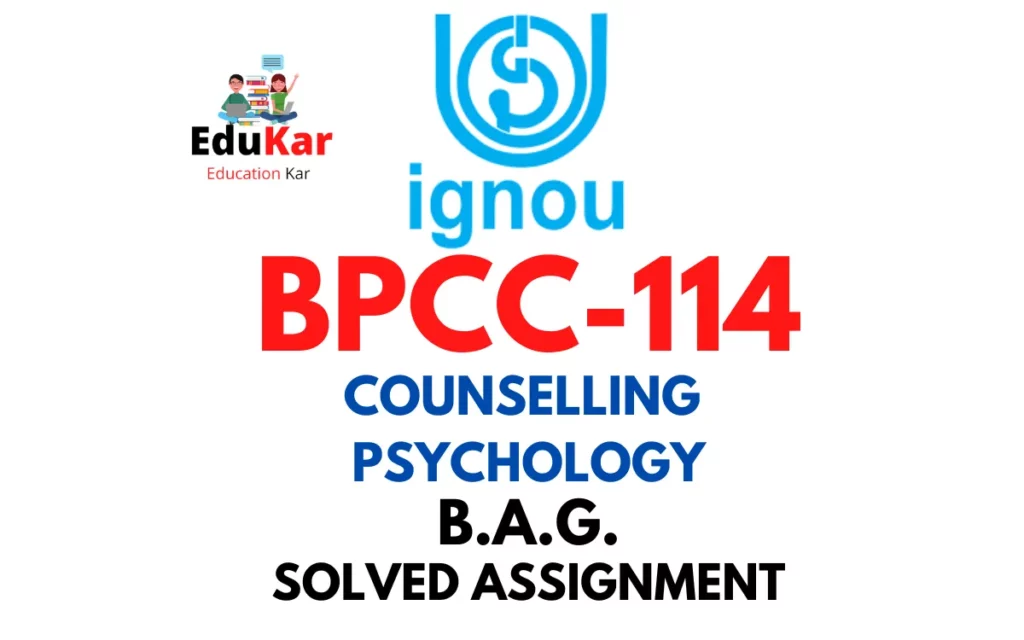
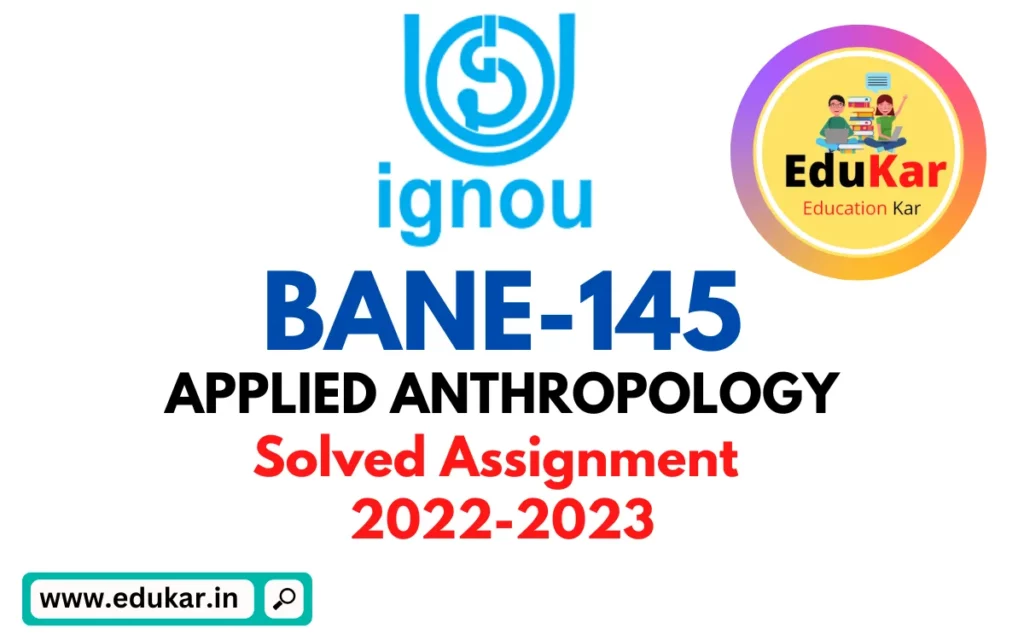

![[Solved Assignment] BPCS 185-DEVELOPING EMOTIONAL COMPETENCE (IGNOU-BAG) 2022-2023 [Solved Assignment] BPCS 185-DEVELOPING EMOTIONAL COMPETENCE (IGNOU-BAG) 2022-2023](https://edukar.in/wp-content/plugins/contextual-related-posts/default.png)
